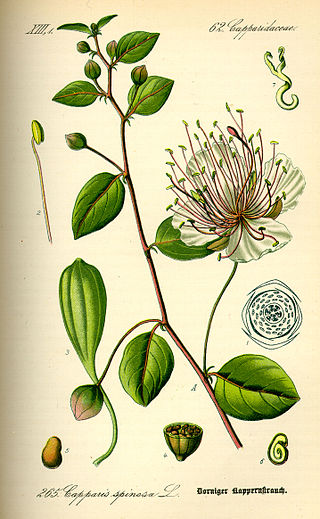
Capparis spinosa, the caper bush, also called Flinders rose, is a perennial plant that bears rounded, fleshy leaves and large white to pinkish-white flowers.

Prunus spinosa, called blackthorn or sloe, is a species of flowering plant in the rose family Rosaceae. The species is native to Europe, western Asia, and regionally in northwest Africa. It is locally naturalized in New Zealand, Tasmania, and the Pacific Northwest and New England regions of the United States.

Aralia spinosa, commonly known as devil's walking stick, is a woody species of plant in the genus Aralia, family Araliaceae, native to eastern North America. The various names refer to the viciously sharp, spiny stems, petioles, and even leaf midribs. It has also been known as Angelica-tree.

Jubilation is the tenth and final studio album by Canadian/American rock group the Band. Recorded in the spring of 1998 in Levon Helm's home studio in Woodstock, New York, it was released on September 15, 1998. For the first time since the group reformed without guitarist and songwriter Robbie Robertson, there were more originals than covers. Songs include "Last Train to Memphis", featuring guest guitarist Eric Clapton, Garth Hudson's solo instrumental closer "French Girls", Rick Danko's "High Cotton" and the ode to Ronnie Hawkins, "White Cadillac".

The spiny turtle is a South-East Asian turtle species. It inhabits lowland and hill rainforest, usually dwelling in the vicinity of small streams in hill areas up to 1,000 m above sea level. It is found in Brunei, Indonesia, Malaysia, Myanmar, the Philippines, Singapore, and Thailand.

Tara spinosa, commonly known as tara (Quechua), also known as Peruvian carob or spiny holdback, is a small leguminous tree or thorny shrub native to Peru. T. spinosa is cultivated as a source of tannins based on a galloylated quinic acid structure. This chemical structure has been confirmed also by LC–MS. It is also grown as an ornamental plant because of its large colorful flowers and pods.

Bursaria spinosa is a small tree or shrub in the family Pittosporaceae. The species occurs mainly in the eastern and southern half of Australia and not in Western Australia and the Northern Territory. Reaching 10 m (35 ft) high, it bears fragrant white flowers at any time of year but particularly in summer. A common understorey shrub of eucalyptus woodland, it colonises disturbed areas and fallow farmland. It is an important food plant for several species of butterflies and moths, particularly those of the genus Paralucia, and native bees.
Acaulospora is a genus of fungi in the family Acaulosporaceae. Species in this genus are widespread in distribution, and form arbuscular mycorrhiza and vesicles in roots.
Acaulospora capsicula is a species of fungus in the family Acaulosporaceae. It forms arbuscular mycorrhiza and vesicles in roots. It can be distinguished easily from other species of the same genus by spore color and wall structure.
Acaulospora denticulata is a species of fungus in the family Acaulosporaceae. It forms arbuscular mycorrhiza and vesicles in roots. Isolated from garden soil in Colombia, the fungus was described as new to science in 1987.
Acaulospora dilatata is a species of fungus in the family Acaulosporaceae. It forms arbuscular mycorrhiza and vesicles in roots. Originally found in West Virginia in soil associated with Andropogon virginicus, the fungus was described as new to science in 1986.
Acaulospora excavata is a species of fungus in the family Acaulosporaceae. It forms arbuscular mycorrhiza and vesicles in roots. The fungus, first isolated from soil under the tree Terminalia ivorensis in the Ivory Coast, was described as new to science in 1994.
Acaulospora foveata is a species of fungus in the family Acaulosporaceae. It forms arbuscular mycorrhiza and vesicles in roots. Found in Mexico in soil associated with sugarcane, the species was described as new to science in 1982.
Acaulospora laevis is a species of fungus in the family Acaulosporaceae. It forms arbuscular mycorrhiza and vesicles in roots.
Acaulospora mellea is a species of fungus in the family Acaulosporaceae. It forms arbuscular mycorrhiza and vesicles in roots.
Acaulospora rugosa is a species of fungus in the family Acaulosporaceae. It forms arbuscular mycorrhiza and vesicles in roots. Originally found in West Virginia in soil associated with Andropogon virginicus, the fungus was described as new to science in 1986.
Acaulospora scrobiculata is a species of fungus in the family Acaulosporaceae. It forms arbuscular mycorrhiza and vesicles in roots. Originally described in Mexico, it is found throughout the world.
Acaulospora sporocarpia is a species of fungus in the family Acaulosporaceae. It forms arbuscular mycorrhiza and vesicles in roots.
Acaulospora tuberculata is a species of fungus in the family Acaulosporaceae. It forms arbuscular mycorrhiza and vesicles in roots. Found growing in forest soil in Panama, the species was described as new to science in 1982.

Hydrolea is the only genus of the family Hydroleaceae of the order Solanales.







